Universities are organisations which are not easy to run and manage. Most employees are highly educated professionals, and as such often self-confident intellectuals with their own independent visions and ideas and not necessarily diligent and willing employees happy to follow any directives of their superiors. They are not easily managed or steered. Leadership in these kind of settings can not easily be characterised. Of course knowledge in the ‘knowledge industry’ of a university this specialised knowledge is a crucial asset for leadership, but also experience with different kinds of settings and situations in which knowledge is  created are of equally great importance. Seniority expressed in this kind of knowledge and experience, often in a very specific specialised field, therefore is an important resource, and often the main criteria for appointing professors. At the same time especially full professors as chair holders are supposed to also have the scope and overview over the broader disciplinary and inter-disciplinary field, as well as the ability to think outside of the box based on experiences with doing ‘science’ in very different organisational situations and settings. These are essential qualification for leadership in knowledge oriented organisations. So even when we would seek to create a flat organisation, we need to accept that we are dealing with a situation where there is a kind of natural hierarchy with respect to the professional background and experience. On the other hand in this situation also an autocratic authoritarian leadership will always fail. There is no-one able to have the competence to overview it all and know it best. So hierarchy is somehow naturally given within specific professional fields, but respectful collegial team work between peers in different disciplinary fields is needed.
created are of equally great importance. Seniority expressed in this kind of knowledge and experience, often in a very specific specialised field, therefore is an important resource, and often the main criteria for appointing professors. At the same time especially full professors as chair holders are supposed to also have the scope and overview over the broader disciplinary and inter-disciplinary field, as well as the ability to think outside of the box based on experiences with doing ‘science’ in very different organisational situations and settings. These are essential qualification for leadership in knowledge oriented organisations. So even when we would seek to create a flat organisation, we need to accept that we are dealing with a situation where there is a kind of natural hierarchy with respect to the professional background and experience. On the other hand in this situation also an autocratic authoritarian leadership will always fail. There is no-one able to have the competence to overview it all and know it best. So hierarchy is somehow naturally given within specific professional fields, but respectful collegial team work between peers in different disciplinary fields is needed.
Given this situation in universities and other organisation in higher education, one often prefers a collegial model of management and leadership. ‘The academic environment seems to be particularly suited to collaborative leadership. The presence of numerous semi-autonomous academic, administrative, and staff structures characterised by relatively highly educated individuals makes the academic particularly susceptible to silo thinking and a lack of a level of communication and interaction across areas necessary for optimal success’ (Mooney, Burns & Chadwick, 2012, p. 144). But what does this entail?
What is collegial leadership?
Bush (2003, p. 65-67) report that collegial models have the following major features (adapted from http://www.opentextbooks.org.hk/ditatopic/17925):
- They are strongly normative in orientation. This is not so much leadership because of formal procedures and division of authorities, and much more based on the normative visions, convictions and strategies, and therefore much more ‘content’ and less process and structure based (Webb & Vulliamy, 1996, p. 443). Usually, taking in the competences and experiences of the leader into account, this also implies that the leader takes the initiative and comes with elaborate proposals. Here hierarchy thus pays a role.
- Collegial models seem to be particularly appropriate for organisations such as universities that have significant numbers of professional staff. Scientists have an authority of expertise that contrasts with the positional authority associated with formal models. Scientists require a measure of autonomy in the lacture hall and in their research but also need to collaborate to ensure a coherent approach to teaching, learning and researching (Brundrett, 1998, p. 307). Collegial models assume that professionals also have a right to share in the wider decision-making process. Shared decisions are likely to be better informed and are also much more likely to be implemented effectively.
- Collegial models assume a common set of values held by members of the organisation. These common values guide the managerial activities of the organisation and are thought to lead to shared educational and research objectives. The common values of professionals form part of the justification for the optimistic assumption that it is always possible to reach agreement about goals and policies. Brundrett (1998, p. 308) goes further in referring to the importance of ‘shared vision’ as a basis for collegial decision-making.
- The size of decision-making groups is an important element in collegial management. They have to be sufficiently small to enable everyone to be heard. This may mean that collegiality works better in elementary schools, or in sub-units, than at the institutional level in secondary schools. Meetings of the whole staff may operate collegially in small departments but may be suitable only for information exchange in larger institutions. The collegial model deals with this problem of scale by building-in the assumption that scientists have formal representation within the various decision-making bodies. The democratic element of formal representation rests on the allegiance owed by participants to their constituencies (Bush, 2003, p. 67).
- Collegial models assume that decisions are reached by consensus. The belief that there are common values and shared objectives leads to the view that it is both desirable and possible to resolve problems by agreement. The decision-making process may be elongated by the search for compromise but this is regarded as an acceptable price to pay to maintain the aura of shared values and beliefs. The case for consensual decision-making rests in part on the ethical dimension of collegiality. Imposing decisions on staff is considered morally repugnant, and inconsistent with the notion of consent.
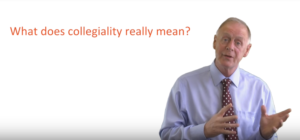 One can also have a look at this brief video by Dan Wood on different collegial leadership styles (click on image):
One can also have a look at this brief video by Dan Wood on different collegial leadership styles (click on image):
Essential to this collegial idea is that leadership should not just be seem as a vertical relationship, but also as a horizontal leadership relation between equals. In practice this implies that there is a hierarchy in decision making based on differing level of qualifications and competences, but that this vertical leadership is based on persuasion creating sufficient support. At the same time the horizontal leadership is based on respectful acceptance of the specific competences of one’s peers. With respect to decision making this requires a  consensus model in which final decisions need to be taken by unanimity, or to put it in other terms, that each of the members of the decision making body have a right to veto the decision. In a working consensus model this will probably be a very rare case. In case of a consensus decision, in a collegial system this decision is also presented as a joint decision, and the decision making body would also be jointly responsible for the implementation of the decision. If no consensus can be reached usually the next higher level of authority would come to a final verdict.
consensus model in which final decisions need to be taken by unanimity, or to put it in other terms, that each of the members of the decision making body have a right to veto the decision. In a working consensus model this will probably be a very rare case. In case of a consensus decision, in a collegial system this decision is also presented as a joint decision, and the decision making body would also be jointly responsible for the implementation of the decision. If no consensus can be reached usually the next higher level of authority would come to a final verdict.
These collegial ideas are, in my personal view, very essential for the kind of Place a university is and for the kind of Culture which characterises our Department as an intellectual breeding ground for great scientific ideas for the future.
Further reading:
Baldridge, J. V. (1971). Power and conflict in the university. Wiley, New York.
Brundrett, M. (1998). What lies behind collegiality, legitimation or control? Educational Management and Administration. 26(3), 305-316.
Burns, D.J. & Mooney, D. (2018) Transcollegial leadership: a new paradigm for leadership. International Journal of Educational Management. 32(1), pp. 57-70.
Bush, T. (2003) Theories of Educational Leadership and Management. Sage, London.
Enderud, H. (1980) Administrative leadership in organised anarchies, International Journal of Institu-tional Management in Higher Education. 4(3), 235-53.
Jarvis, A. (2012) The Necessity for Collegiality: Power, Authority and Influence in the
Middle. Educational Management Administration & Leadership. Vol. 40(4), pp.
480-493.
Miller, T.W. & Miller, J.M. (2001) Educational leadership in the new millennium: a vision for 2020. International Journal of Leadership in Education. 4(2), 181 – 189.
Mooney, D.K., Burns, D.J. &Chadwick, S. (2012) Collegial leadership: deepening collaborative processes to advance mission and outcomes. A Collection of Papers on Self-Study and Institutional Improvement Higher Learning Commission, Chicago. 143-147.
Sergiovanni, T.J. (1991). The Principalship: a reflective practice perspective. Allyn and Bacon, Needham Heights.
Singh, P., Manser, P. & Mestry, R. (2007) Importance of emotional intelligence in conceptualizing collegial leadership in education. South African Journal of Education. 27(3), pp. 541-563.
Wang, V.C.X. & Berger, J. (2010) Critical analysis of leadership needed in higher education. International Forum of teaching and Studies. 6(2), 3-12.
Webb, R. & Vulliamy, G. (1996) A deluge of directives: conflict between collegiality and managerialism in the post-ERA primary school. British Educational Research Journal. 22(4), 441-458.

 Yesterday (18.09.2018), Marc Tribelhorn, a geographer by education, published a commentary in the Neue Zürcher Zeitung (NZZ), the Swiss quality Newspaper about the
Yesterday (18.09.2018), Marc Tribelhorn, a geographer by education, published a commentary in the Neue Zürcher Zeitung (NZZ), the Swiss quality Newspaper about the  development of ‘Bureaucracy’ in today’s world which resembles a lot of what we observe in modern universities and which is next to continuous budget cuts one of main reasons for a killing work load and crumbling quality of teaching and research. Not very new, but story which is right from the heart of many scientists working at universities and doing their utmost to inspire and educate our future generation and to create the knowledge our society needs to address the problems of tomorrow. Here is my free translation of that brief commentary:
development of ‘Bureaucracy’ in today’s world which resembles a lot of what we observe in modern universities and which is next to continuous budget cuts one of main reasons for a killing work load and crumbling quality of teaching and research. Not very new, but story which is right from the heart of many scientists working at universities and doing their utmost to inspire and educate our future generation and to create the knowledge our society needs to address the problems of tomorrow. Here is my free translation of that brief commentary: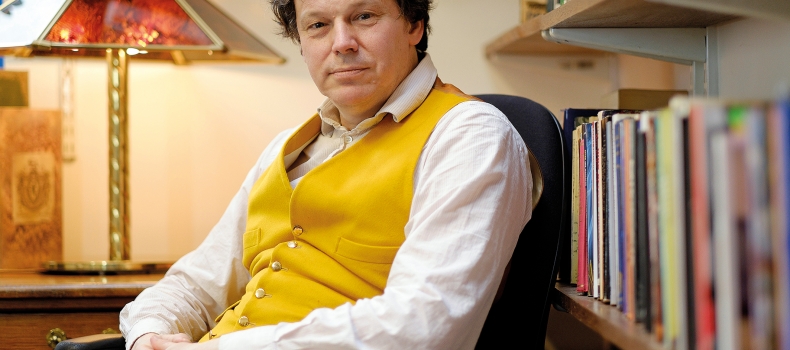 Those who want to express the discomfort in our service society in one word are well served by the Anglicism: ‘bullshit jobs’. For example, David Graeber, ethnologist, anarchist and professor at the prestigious London School of Economics, described a phenomenon which is not limited to public sector, but can also be found in board rooms of private companies: jobs of which do not seem to make any sense and which you probably will also not miss it if they did not exist. Graeber coined this idea on the basis of the answers to the question ‘What do you do for a living?’ posed while socialising at parties. Increasingly the answers puzzled him when professions like ‘Human Resources Management Consultant’, ‘Regulatory Compliance Manager’ or ‘Senior Compensation & Benefits Specialist’ were
Those who want to express the discomfort in our service society in one word are well served by the Anglicism: ‘bullshit jobs’. For example, David Graeber, ethnologist, anarchist and professor at the prestigious London School of Economics, described a phenomenon which is not limited to public sector, but can also be found in board rooms of private companies: jobs of which do not seem to make any sense and which you probably will also not miss it if they did not exist. Graeber coined this idea on the basis of the answers to the question ‘What do you do for a living?’ posed while socialising at parties. Increasingly the answers puzzled him when professions like ‘Human Resources Management Consultant’, ‘Regulatory Compliance Manager’ or ‘Senior Compensation & Benefits Specialist’ were 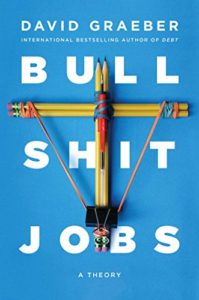 mentioned. In England, in a representative study, nearly 40 percent of respondents said they do not contribute anything useful to society through their wage labour. Graeber first wrote an essay and then a book on this issue that caused a stir around the world because they strike a nerve despite the thin empirics: Many contemporaries have the impression that in the administration and in the middle management of companies more and more well-paid people work without being productive in the narrow sense of the word, i.e. without contributing to consumption and investment. Worse yet, the bullshit jobs are not just an expression, but are the drivers of ever more bureaucratic excesses.
mentioned. In England, in a representative study, nearly 40 percent of respondents said they do not contribute anything useful to society through their wage labour. Graeber first wrote an essay and then a book on this issue that caused a stir around the world because they strike a nerve despite the thin empirics: Many contemporaries have the impression that in the administration and in the middle management of companies more and more well-paid people work without being productive in the narrow sense of the word, i.e. without contributing to consumption and investment. Worse yet, the bullshit jobs are not just an expression, but are the drivers of ever more bureaucratic excesses. Undoubtedly, more and more activities require more and more time to document the work done and to justify the future work, as the Zurich economics professor Bruno S. Frey stated several years ago. We all know this from our everyday work? Everything is diligently questioned, controlled, administered, optimised and reformed, supervised, outsourced, reintegrated and harmonised – in an endless Möbius loop. Rarely, this results in something tangible and useful, but it always produces a lot of paper and ever more administration. What is sold as a recipe for simplification, streamlining and improving work processes often cause exactly the opposite.
Undoubtedly, more and more activities require more and more time to document the work done and to justify the future work, as the Zurich economics professor Bruno S. Frey stated several years ago. We all know this from our everyday work? Everything is diligently questioned, controlled, administered, optimised and reformed, supervised, outsourced, reintegrated and harmonised – in an endless Möbius loop. Rarely, this results in something tangible and useful, but it always produces a lot of paper and ever more administration. What is sold as a recipe for simplification, streamlining and improving work processes often cause exactly the opposite.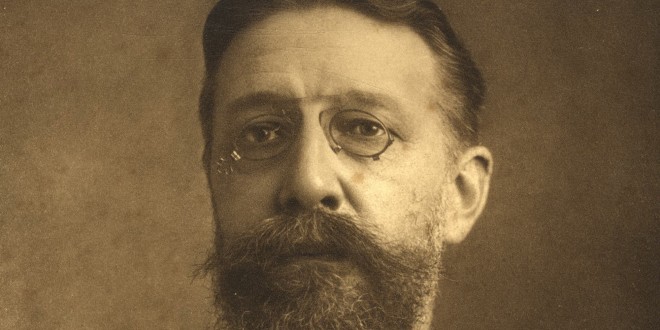 The concept of bureaucracy, when coined in the 19th century, was limited to actions and functioning of powerful civil servants. The sociologist Max Weber later enthused about the ‘formally most rational form of exercise of power’, an ideal for a lean and efficient organisation that guaranteed standardised processes for modern societies. But soon there were signs of degeneration. The dubious reputation of the bureaucracy, for example, observed by British historian Cyril Northcote Parkinson, who had a keen sense of the absurdities of the world of work. In the mid-1950s, the ‘Darwin of the Manager Age’ (‘Time’
The concept of bureaucracy, when coined in the 19th century, was limited to actions and functioning of powerful civil servants. The sociologist Max Weber later enthused about the ‘formally most rational form of exercise of power’, an ideal for a lean and efficient organisation that guaranteed standardised processes for modern societies. But soon there were signs of degeneration. The dubious reputation of the bureaucracy, for example, observed by British historian Cyril Northcote Parkinson, who had a keen sense of the absurdities of the world of work. In the mid-1950s, the ‘Darwin of the Manager Age’ (‘Time’  magazine) published its famous Parkinson’s Law on Administration, which basically anticipated Graeber’s bullshit job thesis. Firstly: ‘Every employee wishes to increase the number of his subordinates, but not the number of his rivals’. Secondly, ‘Employees create work for each other’. And Parkinson says this work will never end because it will always expand, in the same rate as the time available for it. So the bureaucracy keeps on growing – no matter if its actual tasks are reduced or not.
magazine) published its famous Parkinson’s Law on Administration, which basically anticipated Graeber’s bullshit job thesis. Firstly: ‘Every employee wishes to increase the number of his subordinates, but not the number of his rivals’. Secondly, ‘Employees create work for each other’. And Parkinson says this work will never end because it will always expand, in the same rate as the time available for it. So the bureaucracy keeps on growing – no matter if its actual tasks are reduced or not. The emeritus Bernese professor Norbert Thom for economics, who spent decades researching ways of reducing bureaucracy, also observes how the zeitgeist is characterised by the drive to avoid uncertainty and to permanent preservation of evidence. Therefore, with Swiss precision everything is logged, evaluated, quantified and controlled from above, which has led to a massive increase in internal bureaucracy. The corresponding departments would develop a considerable life of their own and grow steadily.
The emeritus Bernese professor Norbert Thom for economics, who spent decades researching ways of reducing bureaucracy, also observes how the zeitgeist is characterised by the drive to avoid uncertainty and to permanent preservation of evidence. Therefore, with Swiss precision everything is logged, evaluated, quantified and controlled from above, which has led to a massive increase in internal bureaucracy. The corresponding departments would develop a considerable life of their own and grow steadily.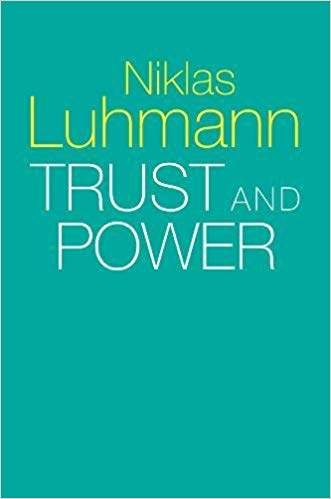 This ‘all risk’ mentality, based on dense regulations, but without any error culture, has consequences that go beyond the loss of efficiency and the immediate cost increases: It smothers the cardinal liberal virtues of employees such as personal responsibility, intrinsic motivation, expertise and common sense. Ultimately, it also undermines the mechanism that, according to sociologist Niklas Luhmann, reduces complexity in modern societies and in companies – trust.
This ‘all risk’ mentality, based on dense regulations, but without any error culture, has consequences that go beyond the loss of efficiency and the immediate cost increases: It smothers the cardinal liberal virtues of employees such as personal responsibility, intrinsic motivation, expertise and common sense. Ultimately, it also undermines the mechanism that, according to sociologist Niklas Luhmann, reduces complexity in modern societies and in companies – trust.
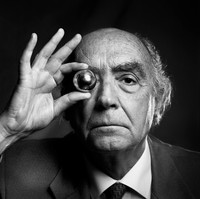 The loss of curiosity is tragic and an important signal, at least, according to the Portuguese writer José Saramago. According to him, old age starts where curiosity ends. He died in 2010 at the age of 86 as a curious man who had never become old.
The loss of curiosity is tragic and an important signal, at least, according to the Portuguese writer José Saramago. According to him, old age starts where curiosity ends. He died in 2010 at the age of 86 as a curious man who had never become old.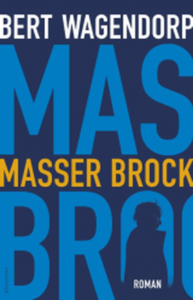 Coincidentally, a novel by my hand appeared last year about a journalist who reached the end of curiosity. When my editor-in-chief read the book Masser Brock, it counts 412 pages, he said that I could also have done with a letter of resignation of two A-4s. In that comment was a truth and an untruth. The truth was that whoever loses his curiosity is no longer suitable for this profession. And then I’m not just talking about the journalist. It had made little difference to the core of the novel if I had made Masser Brock a scientist.
Coincidentally, a novel by my hand appeared last year about a journalist who reached the end of curiosity. When my editor-in-chief read the book Masser Brock, it counts 412 pages, he said that I could also have done with a letter of resignation of two A-4s. In that comment was a truth and an untruth. The truth was that whoever loses his curiosity is no longer suitable for this profession. And then I’m not just talking about the journalist. It had made little difference to the core of the novel if I had made Masser Brock a scientist.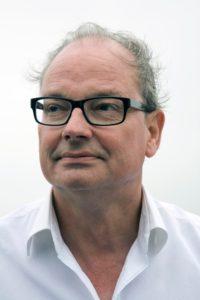 What I want to say with this is that the curious does not choose the easiest way, he gets a lot of trouble and hassle on his neck. But we can not do otherwise. The former ‘Thinker of the Fatherland’, the philosopher René Gude, said that our incessant, curious striving for knowledge is nothing more than an attempt to supplement ourselves, to brush up, to develop. To put an end to a gnawing sense of emptiness and to find an answer to the disturbing question of what we are doing here and why. According to him, curiosity had to do with a desire – without knowing exactly what we desire.
What I want to say with this is that the curious does not choose the easiest way, he gets a lot of trouble and hassle on his neck. But we can not do otherwise. The former ‘Thinker of the Fatherland’, the philosopher René Gude, said that our incessant, curious striving for knowledge is nothing more than an attempt to supplement ourselves, to brush up, to develop. To put an end to a gnawing sense of emptiness and to find an answer to the disturbing question of what we are doing here and why. According to him, curiosity had to do with a desire – without knowing exactly what we desire. And fortunately, because our whole civilisation is based on it, and shaped by it. It is a direct result of our curiosity. The greatest minds of our culture were the most curious spirits. You undoubtedly know Albert Einstein’s famous statement: ‘I have no special talent. I am only passionately curious’. Great scholars and great artists are united in curiosity. In the work of the greatest Dutchman in history, the philosopher Spinoza, the curiosity sparks from it. Look at the work of the painter Picasso and you see a life-long quest driven by pure curiosity.
And fortunately, because our whole civilisation is based on it, and shaped by it. It is a direct result of our curiosity. The greatest minds of our culture were the most curious spirits. You undoubtedly know Albert Einstein’s famous statement: ‘I have no special talent. I am only passionately curious’. Great scholars and great artists are united in curiosity. In the work of the greatest Dutchman in history, the philosopher Spinoza, the curiosity sparks from it. Look at the work of the painter Picasso and you see a life-long quest driven by pure curiosity.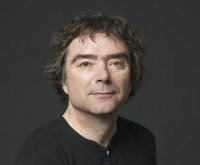 Saramago was a child of poor Portuguese farmers. He was allowed to go to a technical school by grace of God and then worked for years as a car mechanic. But every night he went to the village library to read everything he could get, driven, as he wrote himself, by nothing but curiosity and the will to learn. In 1998 he won the Nobel Prize for literature.
Saramago was a child of poor Portuguese farmers. He was allowed to go to a technical school by grace of God and then worked for years as a car mechanic. But every night he went to the village library to read everything he could get, driven, as he wrote himself, by nothing but curiosity and the will to learn. In 1998 he won the Nobel Prize for literature.